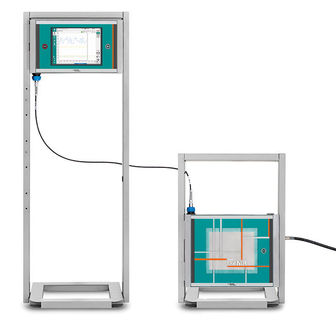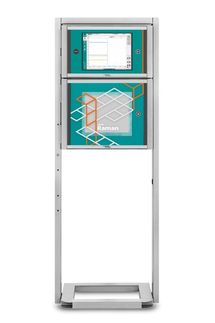Scheuermann's disease
Classification & external resources
| ICD-10
| M42.0
|
| ICD-9
| 732.0
|
| OMIM
| 181440
|
| DiseasesDB
| 11845
|
| eMedicine
| orthoped/555 pmr/129
|
| MeSH
| D012544
|
Scheuermann’s disease is a self-limiting skeletal disorder of childhood.
Scheuermann's disease is considered a form of juvenile osteochondrosis of the spine. It is found mostly in teenagers and presents a significantly worse deformity than postural kyphosis. Patients suffering with Scheuermann’s kyphosis cannot consciously correct their posture. The apex of their curve, located in the thoracic vertebrae, is quite rigid. The sufferer may feel pain at this apex, which can be aggravated by physical activity and by long periods of standing or sitting; this can have a significantly detrimental affect to their lives as their level of activity is curbed by their condition and they may feel isolated or uneasy amongst their peers if they are children, depending on the level of deformity. Whereas in postural kyphosis the vertebrae and disks appear normal, in Scheuermann’s kyphosis they are irregular, often herniated, and wedge shaped over at least three adjacent levels.
The seventh and tenth thoracic vertebrae are most commonly affected. It causes backache and spinal curvature. In very serious cases it may cause internal problems and spinal cord damage.
It is also known as Scheuermann’s kyphosis, since it results in kyphosis.
References
- http://orthoinfo.aaos.org/fact/thr_report.cfm?Thread_ID=247&topcategory=Spine
- http://www.back.com/causes-developmental-scheuermann.html http://www.emedicine.com/pmr/topic129.htm]
- Scheuermann's Kyphosis (Scheuermann's Disease): Abnormal Curvature of the Spine
- http://www.allaboutbackandneckpain.com/html/spinesub.asp?id=27
| Diseases of the musculoskeletal system and connective tissue (M, 710-739) |
|---|
| Arthropathies | Arthritis (Septic arthritis, Reactive arthritis, Rheumatoid arthritis, Psoriatic arthritis, Felty's syndrome, Juvenile idiopathic arthritis, Still's disease) - crystal (Gout, Chondrocalcinosis) - Osteoarthritis (Heberden's node, Bouchard's nodes)
acquired deformities of fingers and toes (Boutonniere deformity, Bunion, Hallux rigidus, Hallux varus, Hammer toe) - other acquired deformities of limbs (Valgus deformity, Varus deformity, Wrist drop, Foot drop, Flat feet, Club foot, Unequal leg length, Winged scapula)
patella (Luxating patella, Chondromalacia patellae)
Protrusio acetabuli - Hemarthrosis - Arthralgia - Osteophyte |
|---|
Systemic connective
tissue disorders | Polyarteritis nodosa - Churg-Strauss syndrome - Kawasaki disease - Hypersensitivity vasculitis - Goodpasture's syndrome - Wegener's granulomatosis - Arteritis (Takayasu's arteritis, Temporal arteritis) - Microscopic polyangiitis - Systemic lupus erythematosus (Drug-induced) - Dermatomyositis (Juvenile dermatomyositis) - Polymyositis - Scleroderma - Sjögren's syndrome - Behçet's disease - Polymyalgia rheumatica - Eosinophilic fasciitis - Hypermobility |
|---|
| Dorsopathies | Kyphosis - Lordosis - Scoliosis - Scheuermann's disease - Spondylolysis - Torticollis - Spondylolisthesis - Spondylopathies (Ankylosing spondylitis, Spondylosis, Spinal stenosis) - Schmorl's nodes - Degenerative disc disease - Coccydynia - Back pain (Radiculopathy, Neck pain, Sciatica, Low back pain) |
|---|
| Soft tissue disorders | muscle: Myositis - Myositis ossificans (Fibrodysplasia ossificans progressiva)
synovium and tendon: Synovitis - Tenosynovitis (Stenosing tenosynovitis, Trigger finger, DeQuervain's syndrome)
bursitis (Olecranon, Prepatellar, Trochanteric)
fibroblastic (Dupuytren's contracture, Plantar fasciitis, Nodular fasciitis, Necrotizing fasciitis, Fasciitis, Fibromatosis)
enthesopathies (Iliotibial band syndrome, Achilles tendinitis, Patellar tendinitis, Golfer's elbow, Tennis elbow, Metatarsalgia, Bone spur, Tendinitis)
other, NEC: Muscle weakness - Rheumatism - Myalgia - Neuralgia - Neuritis - Panniculitis - Fibromyalgia |
|---|
| Osteopathies | disorders of bone density and structure: Osteoporosis - Osteomalacia - continuity of bone (Pseudarthrosis, Stress fracture) - Monostotic fibrous dysplasia - Skeletal fluorosis - Aneurysmal bone cyst - Hyperostosis - Osteosclerosis
Osteomyelitis - Avascular necrosis - Paget's disease of bone - Algoneurodystrophy - Osteolysis - Infantile cortical hyperostosis |
|---|
| Chondropathies | Juvenile osteochondrosis (Legg-Calvé-Perthes syndrome, Osgood-Schlatter disease, Köhler disease, Sever's disease) - Osteochondritis - Tietze's syndrome |
|---|
| See also congenital conditions (Q65-Q79, 754-756) |
|







